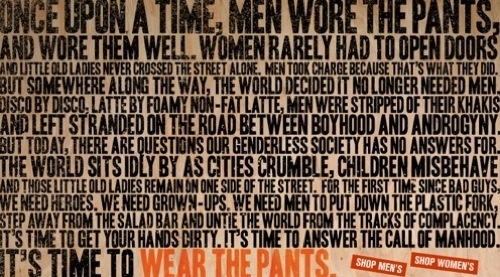In a sweet anecdote, Sociologist Michael Kimmel talks about how he was playing the game of opposites with his son. “What is the opposite of up?” “Down.” “What is the opposite of awake?” “Asleep.” “What is the opposite of man?” He asked.
And his son replied, “Boy.”
Kimmel tells this story as a glimpse into an alternative world in which men do not define themselves in opposition to women, but see manhood in terms of maturity.
We don’t live in that world. And Dockers thinks it can sell khakis by encouraging men to define themselves as not-women in its new man-ifesto ad campaign (text after the jump):

Of course, what is really interesting about this ad is the way that it defines manhood as in opposition to all kinds of things: womanhood, of course, but also boyhood, and feminine manhood, androgyny, and whatever disco, plastic forks, latte drinking, and salad represent. What do men get? Being in charge of women and children… and dirty hands (maybe the dirt is metaphorical).
I’d much rather live in Kimmel Jr.’s world.
(Thanks to Christina W. for encouraging us to write about this ad.)
For a similar ad, see this Ketel One commercial expressing nostalgia for a pre-feminist time. And, for lots of material documenting the new pop culture version of masculinity, browse our gender: masculinity tag.
Jump for a transcript of the text:







